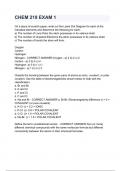Chem 219 Study guides, Class notes & Summaries
Looking for the best study guides, study notes and summaries about Chem 219? On this page you'll find 290 study documents about Chem 219.
All 290 results
Sort by
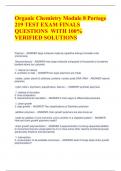 Popular
Popular
-
Organic Chemistry Module 8 Portage 219 TEST EXAM FINALS QUESTIONS WITH 100% VERIFIED SOLUTIONS
- Exam (elaborations) • 15 pages • 2023
-
Available in package deal
-
- $10.99
- 9x sold
- + learn more
Organic Chemistry Module 8 Portage 219 TEST EXAM FINALS QUESTIONS WITH 100% VERIFIED SOLUTIONS Polymer - ANSWER large molecule made by repetitive linking of smaller units (monomers) Macromolecule - ANSWER very large molecule composed of thousands of covalently bonded atoms (ex: polymer) 1. natural (in nature) 2. synthetic (in lab) - ANSWER two ways polymers are made rubber, carbs: starch & cellulose, proteins, nucleic acids DNA, RNA - ANSWER natural polymers nylon, teflon, sty...
CHEM 219 COMBINATION (PROBLEM SET) FROMMODULE 2 TO MODULE 8 Lab Gallaher Portage Learning 2023-2024
CHEM 219 Module 2 Problem Set Principles of Organic Chemistry with Lab Gallaher Portage Learning
CHEM 219 Module 4 Problem Set Principles of Organic Chemistry with Lab-Gallaher Portage Learning
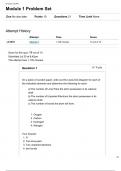
-
CHEM 219 Module 1 Problem Set Principles of Organic Chemistry with Lab Gallaher Portage Learning.
- Exam (elaborations) • 18 pages • 2024
- Available in package deal
-
- $11.99
- 1x sold
- + learn more
CHEM 219 Module 1 Problem Set Principles of Organic Chemistry with Lab Gallaher Portage Learning. Score for this quiz: 10 out of 10 Submitted Jul 25 at 8:42pm This attempt took 1,135 minutes. Question 1 0 / 0 pts Your Answer: On a piece of scratch paper, write out the Lewis Dot Diagram for each of the indicated elements and determine the following for each: a) The number of Lone Pairs the atom possesses in its valence shell. b) The number of Unpaired Electrons the atom possesses in its...

-
Chem 219: Module 2 Exam Questions With 100% Correct Answers
- Exam (elaborations) • 12 pages • 2024
- Available in package deal
-
- $12.49
- 3x sold
- + learn more
Chem 219: Module 2 Exam Questions With 100% Correct Answers What are hydrocarbons? - answerMolecules composed of only the elements carbon and hydrogen What are the two major classes of hydrocarbons? - answerAromatic (benzene) and aliphatic (alkanes, alkenes, alkynes) What is the main source of hydrocarbons? - answerFossil fuels like coal, petroleum, and natural gas obtained by mining and drilling. What are Alkanes? - answerThey are saturated hydrocarbons because their skeleton is only c...
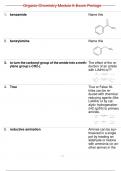
-
Chem 219 Organic Chemistry Module 6 Exam Portage updated questions with 100% correct answers | updated and verified 2024
- Exam (elaborations) • 23 pages • 2024
-
Available in package deal
-
- $7.99
- 2x sold
- + learn more
Chem 219 Organic Chemistry Module 6 Exam Portage updated questions with 100% correct answers | updated and verified 2024
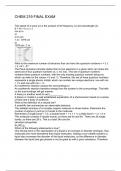
-
CHEM 219 FINAL EXAM Q&A 2024
- Exam (elaborations) • 13 pages • 2024
-
- $13.49
- 1x sold
- + learn more
The speed of a wave (c) is the product of its frequency (ν) and wavelength (λ). E = hv = h x c / λ nm to m or m to nm 1 m / 10^9 nm or 10^9 nm / 1 m What is the maximum number of electrons that can have the quantum numbers n = 3, ℓ = 2, mℓ = -2? The Pauli exclusion principle states that no two electrons in a given atom can share the same set of four quantum numbers (n, ℓ, mℓ, ms). This set of quantum numbers contains three quantum numbers, with the only missing quantum num...
CHEM 219 EXAM 1 ALL QUESTIONS WITH COMPLETE SOLUTION.
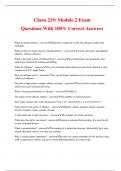
-
Chem 219: Module 2 Exam Questions With 100% Correct Answers
- Exam (elaborations) • 12 pages • 2024
- Available in package deal
-
- $12.49
- 1x sold
- + learn more
Chem 219: Module 2 Exam Questions With 100% Correct Answers What are hydrocarbons? - answerMolecules composed of only the elements carbon and hydrogen What are the two major classes of hydrocarbons? - answerAromatic (benzene) and aliphatic (alkanes, alkenes, alkynes) What is the main source of hydrocarbons? - answerFossil fuels like coal, petroleum, and natural gas obtained by mining and drilling. What are Alkanes? - answerThey are saturated hydrocarbons because their skeleton is only c...

Study stress? For sellers on Stuvia, these are actually golden times. KA-CHING! Earn from your study resources too and start uploading now. Discover all about earning on Stuvia





